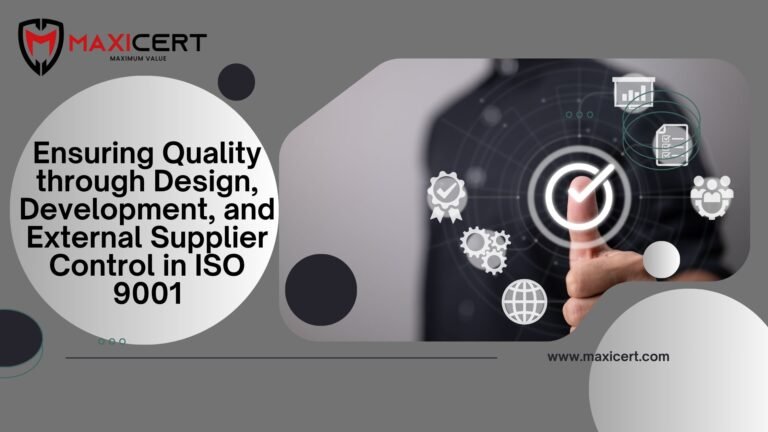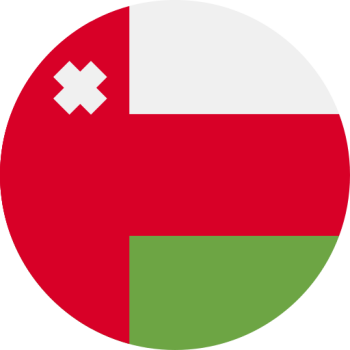Ensuring Quality through Design, Development, and External Supplier Control in ISO 9001

Introduction
Effective quality management goes beyond in-house processes—it extends to external suppliers and service providers. ISO 9001:2015 emphasizes the importance of supplier control (Clause 8.4) and production and service provision (Clause 8.5) to ensure product quality and compliance. This blog explores risk-based supplier management, verification strategies, and production control techniques to help businesses streamline operations and maintain high-quality standards. For organizations seeking ISO certification globally, working with the best consultant, like Maxicert, ensures full compliance and performance.
Clause 8.4.2 – Type and Extent of Control
According to clause 8.4.2 of ISO 9001, the organization is required to take a risk-based approach to determine the type and extent of controls appropriate to particular external providers and their products and services.
The standard requires you to consider two main points:
The potential impact of the externally provided processes, products, and services on your ability to meet requirements.
Example: In food production, milk and sugar both require preservation, but milk, having higher spoilage risk, demands stricter control than sugar.
The perceived effectiveness of controls applied by the external provider.
Evaluate products and services through:
Incoming inspections
Service checks (e.g., cleanliness after a cleaning service)
Evaluate the provider’s operational condition through:
Equipment maintenance
Critical control point monitoring
Personnel behavior and skills
Maxicert, the best ISO consultant, helps organizations worldwide to implement this clause effectively, ensuring global compliance and operational excellence.
Request A Free Quote
Did You Get What You Ordered?
Most organizations practice some form of monitoring and measurement, from simply verifying delivery quantity to conducting full inspections at the external provider’s premises.
Decide your verification methods (inspections, tests) based on the risk and nature of the product/service.
Examples include:
Visual checks for delivered quantity
Sample inspections
Reviewing certificates of analysis
On-site evaluations for complex services like design, transportation, etc.
With Maxicert, companies can apply industry-best techniques for monitoring external providers, ensuring successful ISO certification all over the world.
Clause 8.4.3 – Information for External Providers
In order to get what you need, instructions should leave no doubt as to what it is that you want. Instructions are preferably given as a written order or electronic communication.
Remember that telephoned instructions are open to misunderstanding by your external provider and you should take precautions to ensure that your instructions are understood.
You should keep a record of what was ordered so you can confirm that you got what you asked for.
This part of the requirement outlines the details that should be included, as appropriate, in stating your requirements for the control of externally provided products and services.
The extent to which the details listed in items a) to f) apply depends on the extent to which the products and services being ordered affect the organization and the quality of your products and services.
- the products and services to be provided or the processes to be performed on behalf of the organization;
- approval or release of products and services, methods, processes, or equipment;
It is essential that all relevant details of the products and services wanted are clearly stated at the time of ordering. These can include drawing, catalogue or model numbers and required delivery date -and place. In some cases, the complete description could be covered by a catalogue number, or a part number. Other factors that may need to be clearly stated could relate to packaging, labelling. certificates of analysis or test results.
While it is essential to fully describe what you want, unnecessary detail can lead to misunderstanding and incorrect delivery.
The written purchase order should be checked prior to issue. In a small organization, it will probably be the person who does the buying who will do the checking for adequacy. This could simply involve reading the order, initialing and dating it.
In case of outsourcing. Inform the external provider necessary maintenance condition for the equipment, a plan that describes the requirements for the manufacturing process.
- competence of personnel, including necessary qualification, Necessary skill and/or qualification for instance such as for soldering, welding, sommelier, hygiene control, a cook etc.
- their interactions with the organization’s quality management system;
For examples, when outsourcing is a part of the manufacturing process, such as assemble process, inspection process etc., to the external provider, the organization has to inform, where these processes positions in the organizations QMS
In addition, what is the process before and what is after the process,what inputs are needed and what outputs are intended to the next process. Moreover, provide information about what controls are necessary
- the control and monitoring of the external provider’s performance to be applied by the organization. Inform the external providers what performance is to be controlled and to be monitored by the organization.
Then inform how the organization evaluate and re-evaluates the external provider’s performance.
- Verification activities that the organization, or its customer, intends to perform at the external provider’s premises.
If you order products and services from an external provider, and wish to monitor or measure these at the external provider’s premises, the arrangements for these activities need to be agreed and included in your order.
Some examples of the fulfilment of this requirement are an interior decorator viewing curtain fabrics and monitoring employees being trained at a training facility.
If a customer wants to visit your external provider’s premises to check the product, this needs to be stated in both the customer’s order to you and in your order to the external provider.
Whether or not the customer actually does this, you are still responsible for ensuring that all the products obtained from external providers meet the requirement of
Clause 8.5 – Production and Service Provision
In many organizations, this control is exercised through internal orders, drawings, production schedules, service specifications, service performance criteria, and operator instructions.
You will need clearly understandable specifications or work instructions which provide the information necessary to ensure that the products conform to the specified customer requirements. One of the key issues here is that it is not necessary to write a document containing all the details which a competent operator would be expected to know. (adjust to new standard-level of experience consider competence)
Process controls should also include how the process condition or the product itself is to be monitored. For example, a baker might monitor the oven temperature or the color of the loaves of both. To assist the monitoring process, there can be charts or visual aids to indicate the acceptable oven temperature range, or photographs to show the preferred color and shape of the loaves.
In the service industry, controls might be related to the monitoring and measuring that is used in the organization. For example, in a call center, the call may be monitored for performance. Specific scripts to be used for certain situations might also be used to ensure that the answers are provided in the manner in which the organization prefers.
How to Get ISO Certified: Step-by-Step
- Analyze your current methods with a gap analysis
- Make modifications and align processes to the required standard
- Educate your staff and delegate corresponding tasks
- Conduct compliance internal audits
- Certification audit with accredited organization
- Obtain ISO certification (3 year validity with surveillance audits)
Conclusion
Quality assurance in design, development, and external supplier control is essential for long-term business success. By implementing robust verification, monitoring, and process controls as outlined in ISO 9001 Clauses 8.4 and 8.5, organizations can:
Reduce nonconformity risks
Improve product/service consistency
Ensure compliance with customer and legal expectations
Partner with Maxicert—your trusted global consultant for ISO certification—to elevate your supplier management and production quality to international standards.

Get In Touch

Get In Touch

Get In Touch
Need A Free Estimate?
Get a free consultation and Checklist to get certified for ISO , HALAL, CE Mark Certification.
FAQ
Why is supplier control important in ISO 9001?
Supplier control ensures that external products/services meet quality and regulatory requirements. This helps reduce risks of nonconformance and enhances customer satisfaction.
What are the key elements of production control in ISO 9001?
Key elements include:
Clear specifications and instructions
Skilled personnel
Process monitoring tools
Visual or automated aids
How can Maxicert help in ISO certification?
Offers expert ISO consultants across the globe
Designs supplier control systems
Trains teams for production quality control
Provides full ISO certification services



